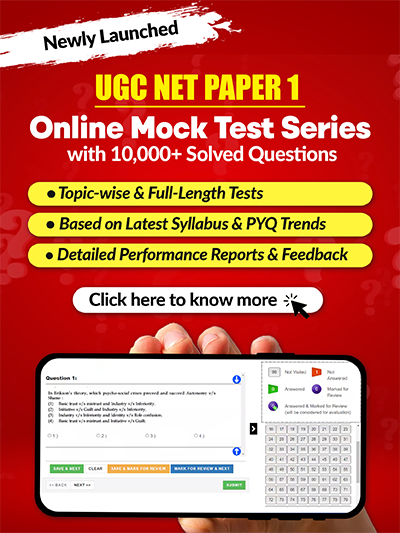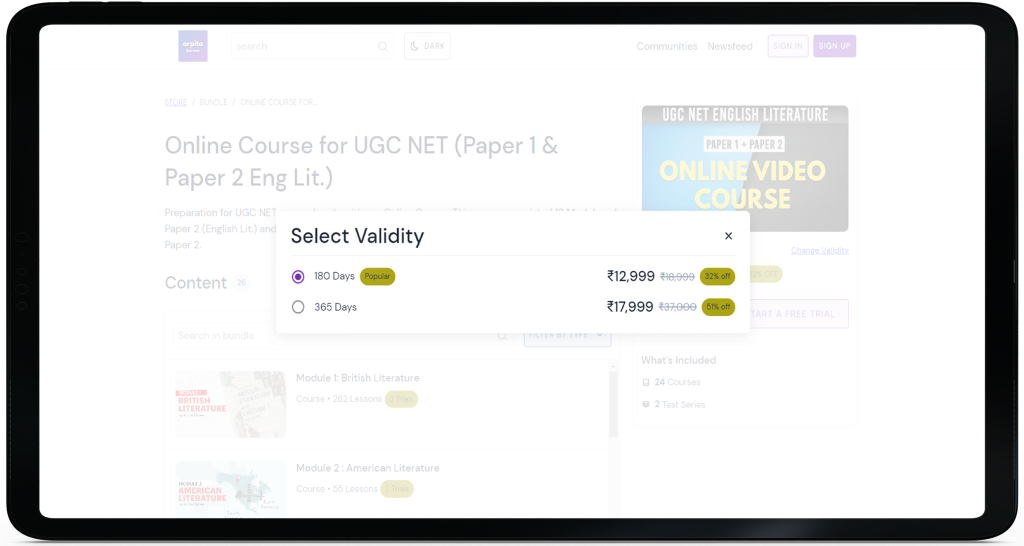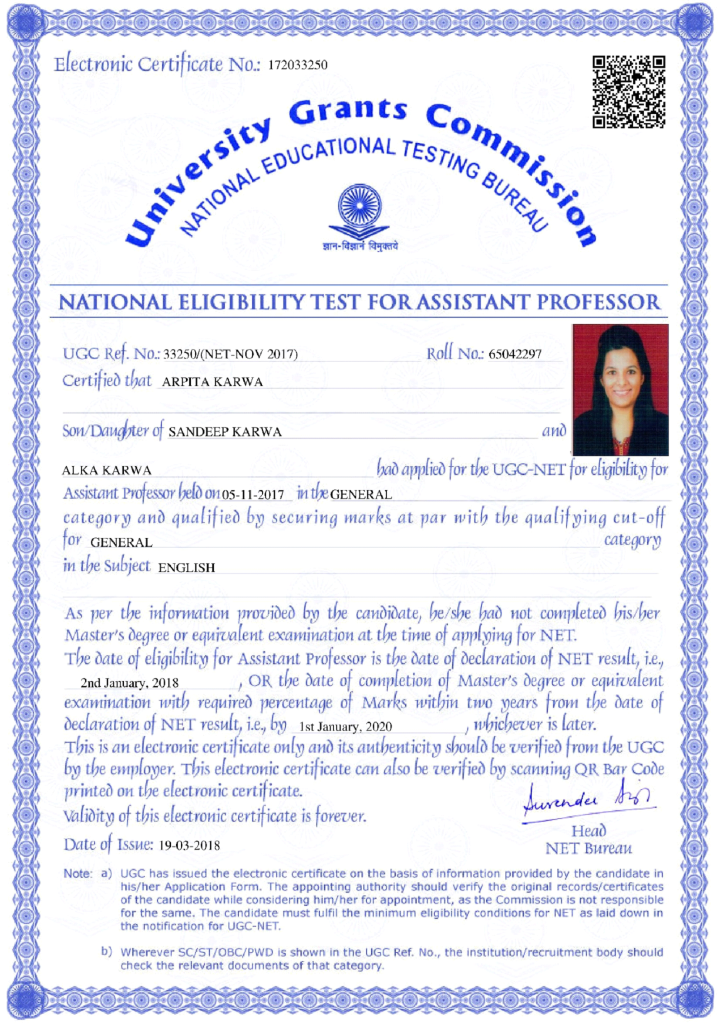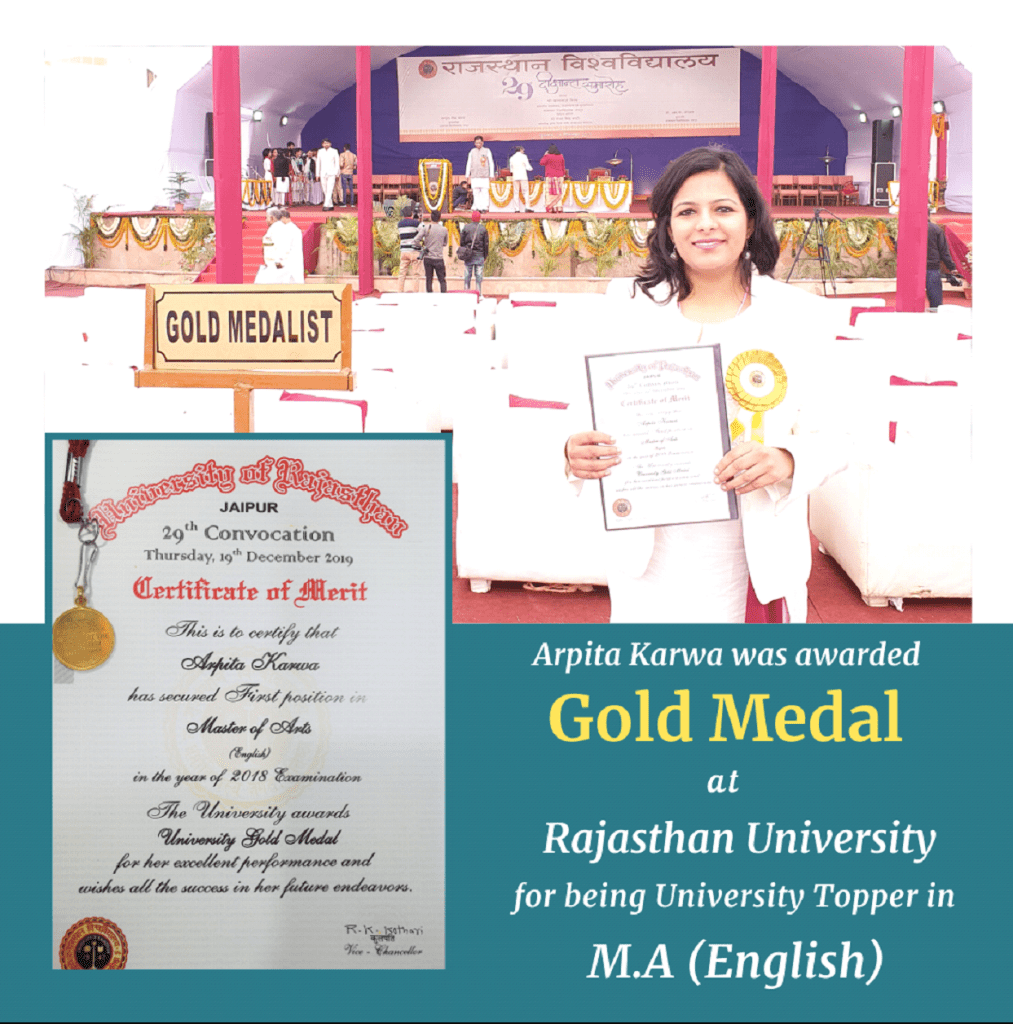December 2023 : Paper 2 (Conducted on 6th Dec 2023 : Morning Shift)
January 5, 2024 2025-10-13 14:37December 2023 : Paper 2 (Conducted on 6th Dec 2023 : Morning Shift)
December 2023: Paper 2 (Conducted on 6th Dec 2023 : Morning Shift)
Q.1) Sharankumar Limbale argues that Dalit literature is unique because:
(A) This brings out the Dalit reality which is liminal in time and space.
(B) This has unique historical and ideological concerns.
(C) This offers literary and cultural representations of marginalised and dispossessed people.
(D) This brings out narratives and discourses of pity.
(E) It uses disrespectful and offensive language towards revered figures.
Choose the most appropriate answer from the options given below:
[1] (A), (B) and (C) Only
[2] (B), (C) and (D) Only
[3] (A), (B) and (D) Only
[4] (A), (C) and (E) Only
Answer: [1]
Q.2) Edgar Allan Poe is often called as the originator of the short story as an established genre. He defined ‘the prose tale’ as:
[1] A narrative which can be read at one sitting of from half an hour to two hours.
[2] A narrative which can be read within five minutes or less.
[3] A narrative that can be read at one sitting of from one hour to four hours.
[4] A narrative that may be concluded and enjoyed in the single spell of less than half an hour.
Answer: [1]
Q.3)”An Introduction” by Kamla Das is:
[1] A short story on the theme of people’s rights and freedom
[2] An introduction to her autobiography My Story
[3] An essay on the theme of gender rights
[4] A poem of resistance and protest
Answer: [4]
Q.4) Which of the following statements/concepts are relevant for understanding of Postmodernism?
(A) Postmodernism and Postcolonialism are mutually dependent in responding to colonial experience.
(B) Lyotard argues that the Postmodern condition is characterised by a deeply felt scepticism towards metanarratives.
(C) Edward W. Said has been instrumental in postmodern theory and criticism.
(D) Jean Baudrillard’s Simulacra and Simulations is a seminal postmodern text.
(E) Fredric Jameson argues that parody has been replaced by pastiche in postmodernism.
Choose the most appropriate answer from the options given below:
[1] (B), (D) and (E) Only
[2] (A), (B) and (D) Only
[3] (B), (C) and (E) Only
[4] (C), (D) and (E) Only
Answer: [1]
Q.5) “All writers since Chaucer have come from the middle class… have had good, at least expensive education….”
Where has Virginia Woolf explained it?
[1] Mrs. Dalloway
[2] To the Lighthouse
[3] The Leaning Tower
[4] A Room of One’s Own
Answer: [3]
Q.6) What is the correct order of publication of the novels of Charles Dickens?
(A) Great Expectations
(B) Hard Times
(C) Oliver Twist
(D) David Copperfield
(E) A Tale of Two Cities
Choose the correct answer from the options given below:
[1] (E), (C), (A), (B), (D)
[2] (C), (D), (B), (E), (A)
[3] (B), (A), (D), (C), (E)
[4] (D), (B), (C), (A), (E)
Answer: [2]
Q.7) Which among the following writers are popular for partition narratives?
(A) Krishna Sobti
(B) Shashi Deshpande
(C) Saros Cowasjee
(D) Bharti Mukherjee
(E) Rahi Masoom Raza
Choose the correct answer from the options given below:
[1] (A), (B) and (C) Only
[2] (B), (C) and (D) Only
[3] (A), (C) and (E) Only
[4] (C), (D) and (E) Only
Answer: [3]
Q.8) Arrange the chronological sequence in which the following works were published:
(A) Culture and Society
(B) Culture and Anarchy
(C) To Hell with Culture
(D) Studies in Dying Culture
(E) Notes towards the Definition of Culture
Choose the correct answer from the options given below:
[1] (E), (B), (A), (D), (C)
[2] (C), (E), (D), (B), (A)
[3] (A), (D), (E), (B), (C)
[4] (B), (A), (D), (C), (E)
Answer: Answer given wrong
Q.9) Match List – I with List – II.
List – I (Character)
List – II (Novel)
(A) Sethe
(I) The Handmaid’s Tale
(B) Okonkwo
(II) Beloved
(C) Offred
(III) Things Fall Apart
(D) Winston Smith
(IV) Nineteen Eighty-Four
Choose the correct answer from the options given below:
[1] (A)-(II), (B)-(III), (C)-(I), (D)-(IV)
[2] (A)-(III), (B)-(II), (C)-(IV), (D)-(I)
[3] (A)-(I), (B)-(III), (C)-(II), (D)-(IV)
[4] (A)-(IV), (B)-(1), (C)-(III), (D)-(II)
Answer: [1]
Q.10) Which among the following statements are true?
(A) Miscegenation is a sexual relationship or marriage between the people of the same race
(B) Creole is a language that has evolved from a pidgin but serves as the native language of a speech community
(C) Indian tribal people are popularly termed as aboriginals
(D) Mulatto is a person of mixed white and black ancestry
(E) Australian indigenous population is termed as Red Indians
Choose the most appropriate answer from the options given below:
[1] (A) and (E) Only
[2] (B) and (C) Only
[3] (C) and (D) Only
[4] (B) and (D) Only
Answer: [4]
Q.11) Which of the following is true of Edward Said’s Orientalism?
(A) It was published in 1979.
(B) Utilises the concept of discursive formulation as argued by Foucault.
(C) He has taken up the detailed analysis of imaginative geography and representation of the Orient.
(D) It is one of the foundational texts of Postcolonial theory.
(E) It puts to use Barthes’ concept of ‘death of the author’.
Choose the most appropriate answer from the options given below:
[1] (A), (B) and (E) Only
[2] (A), (B) and (C) Only
[3] (A), (C) and (E) Only
[4] (B), (C) and (D) Only
Answer: [4]
Q.12) Given below are two statements: one is labelled as Assertion (A) and the other is labelled as Reason (R).
Assertion (A): Culture is one of the two or three most complicated words in the English language.
Reason (R): This is mainly because of several different though related meanings have emerged at particular moments throughout its long history.
In the light of the above statements, choose the most appropriate answer from the options given below
[1] Both (A) and (R) are true and (R) is the correct explanation of (A).
[2] Both (A) and (R) are true but (R) is NOT the correct explanation of (A).
[3] (A) is true but (R) is false.
[4] (A) is false but (R) is true.
Answer: [1]
Q.13) Use of broader principles of research underscored by philosophical rationales is termed as:
[1] Research Methods
[2] Research Tools
[3] Research Techniques
[4] Research Methodology
Answer: [4]
Q.14) Who among the following declared in 1920 that “there is no longer any intellectual life in England”?
[1] Dorothy Richardson
[2] Virginia Woolf
[3] Ezra Pound
[4] T.S. Eliot
Answer: [3]
Q.15) Identify the poet of the following poems:
(a) The Skylark
(b) The Badger
(c) The Gypsy Camp
(d) First Love
[1] P.B. Shelley
[2] John Clare
[3] Lord Byron
[4] Robert Burns
Answer: [2]
Q.16) The term ‘simulacra’ in postmodern discourse is about:
(A) Absence of vivid representation of reality
(B) Artificially produced reality dubbed as authentic
(C) A rejection of modernistic view of reality
(D) The gap between the perception and reality
(E) The psychological interplay at the level of subconscious
Choose the correct answer from the options given below:
[1] (C) and (E) Only
[2] (D) and (E) Only
[3] (A) and (B) Only
[4] (B) and (C) Only
Answer: [3]
Q.17) Which two cities are referred in Charles Dickens’ A Tale of Two Cities?
[1] Paris and Venice
[2] Venice and Florence
[3] London and Paris
[4] London and Birmingham
Answer: [3]
Q.18) Transcendental Club was a group of American intellectuals for philosophical discussions. Which text among the following is taken as a short treatise on Transcendentalism?
[1] Emerson’s Nature
[2] Thoreau’s Walden
[3] Whitman’s Leaves of Grass
[4] Thoreau’s Civil Disobedience
Answer: [1]
Q.19) Match List – I with List – II.
List – I (Text)
List – II (Author)
(A) The Collaborator
(I) Amandeep Sandhu
(B) The Garden of Solitude
(II) Shahnaz Bashir
(C) Roll of Honour
(III) Siddhartha Gigoo
(D) The Half Mother
(IV) Mirza Waheed
Choose the correct answer from the options given below:
[1] (A)-(IV), (B)-(III), (C)-(I), (D)-(II)
[2] (A)-(I), (B)-(II), (C)-(III), (D)-(IV)
[3] (A)-(II), (B)-(III), (C)-(IV), (D)-(I)
[4] (A)-(III), (B)-(1), (C)-(II), (D)-(IV)
Answer: [1]
Q.20) Name the author/writer who is not associated with British Cultural Studies.
[1] I.A. Richards
[2] Richard Hoggart
[3] Raymond Williams
[4] Stuart Hall
Answer: [1]
Q.21) Given below are two statements:
Statement (I): Non-fictional narrative Follow the Rabbit-Proof Fence by Doris Pilkington is based on the real-life experiences of three aboriginal girls who fled from the Moore River Native Settlement.
Statement (II): The names of the three girls are- Molly, Daisy and Mary.
In the light of the above statements, choose the most appropriate answer from the options given below:
[1] Both Statement (I) and Statement (II) are correct
[2] Both Statement (I) and Statement (II) are incorrect
[3] Statement (I) is correct but Statement (II) is incorrect
[4] Statement (I) is incorrect but Statement (II) is correct
Answer: [3]
Q.22) Arrange the chronological sequence in which the following works of Richard Hoggart were published:
(A) An Imagined Life
(B) The Uses of Literacy
(C) Higher Education: Demand and Response
(D) A Local Habitation
(E) A Sort of Clowning
Choose the correct answer from the options given below:
[1] (A), (B). (D), (E), (C)
[2] (D), (B), (C), (A), (E)
[3] (B), (E), (A), (C), (D)
[4] (B), (C), (D), (E), (A)
Answer: [4]
Q.23) Match List – I with List – II.
List – I (Character)
List – II (Work)
(A) Christophine
(I) Wuthering Heights
(B) Zillah
(II) Wide Sargasso Sea
(C) Estella
(III) Things Fall Apart
(D) Ekwefi
(IV) Great Expectations
Choose the correct answer from the options given below:
[1] (A)-(IV), (B)-(III), (C)-(II), (D)-(I)
[2] (A)-(I), (B)-(II), (C)-(III), (D)-(IV)
[3] (A)-(II), (B)-(I), (C)-(IV), (D)-(III)
[4] (A)-(III), (B)-(IV), (C)-(I), (D)-(II)
Answer: [3]
Q.24) Which of the following characteristics of She Stoops to Conquer is not correct?
[1] It is endowed with an ingenious and lively plot.
[2] It does not cast excellent characters.
[3] It has a vivacious and delightful style.
[4] It lacks the Restoration grossness.
Answer: [2]
Q.25) Antonio Gramsci’s Prison Notebooks primarily deals with:
[1] Pain of a prisoner during colonial times
[2] Recollections of love, romance and blissful life
[3] Philosophy, culture, literature and the role of intellectuals
[4] Exploitation of blacks during the colonial times
Answer: [3]
Q.26) Given below are two statements:
Statement (I): A Room of One’s Own is a feminist essay about women’s education, exclusion and writing by Virginia Woolf.
Statement (II): In Other Worlds is a collection of essays written by Edward W. Said on contemporary ideas such as psychoanalysis and social theory.
In the light of the above statements, choose the most appropriate answer from the options given below
[1] Both Statement (I) and Statement (II) are true
[2] Both Statement (I) and Statement (II) are false
[3] Statement (I) is true but Statement (II) is false
[4] Statement (I) is false but Statement (II) is true
Answer: [3]
Q.27) Which of the following is true about Tennessee Williams’ A Street Car Named Desire?
(A) It is set in New Orleans.
(B) The protagonist is a Mississippi landowner.
(C) It ends with Blanche’s defeat and departure.
(D) Tom Wingfield is the narrator.
(E) Laura and Stella are cousins.
Choose the correct answer from the options given below:
[1] (A) and (D) Only
[2] (A) and (C) Only
[3] (B) and (C) Only
[4] (B) and (E) Only
Answer: [2]
Q.28) Prose romances preceded the emergence of novel as a popular literary genre. Which texts among the following fall under the category of Prose Romance?
[1] The Pilgrim’s Progress and The Spectator
[2] Oroonoko and The Fair Jilt
[3] Pamela and Clarissa
[4] Amelia and Ferdinand, Count Fathom
Answer: [2]
Q.29) Which of the following statement(s) best describe Anna Karenina’s situation and worldview?
(A) Anna is deeply committed to the family and children
(B) Anna’s choices were more an outcome of passion and instinct
(C) Anna accepted the exile to which she was condemned
(D) Anna’s passionate spirit and determination to live life at her own terms make her so unique
(E) She became a victim of rampant patriarchal forces
Choose the most appropriate answer from the options given below:
[1] (A), (C) and (D) Only
[2] (A), (B) and (E) Only
[3] (A), (D) and (E) Only
[4] (A), (B) and (D) Only
Answer: [3]
Q.30) Which of the following assumptions are true in the context of New Criticism?
(A) The new movement in literature popularised closed reading of the text.
(B) The leading critics of New Criticism are Allen Tate, Robert Penn Warren, R.P. Blackmur and Kenneth Burke.
(C) The critical approach is extensively used in the study of novels and plays.
(D) This critical approach tends to discredit historical, social and political contexts of a work of literature.
(E) J.C. Ransom published a book New Criticism wherein he appreciates I.A. Richards, William Empson and T.S. Eliot.
Choose the correct answer from the options given below:
[1] (A), (B) and (C) Only
[2] (B), (C) and (D) Only
[3] (C), (D) and (E) Only
[4] (A), (B) and (D) Only
Answer: [4]
Q.31) Roland Barthes in his “Introduction to the Structural Analysis of Narratives” (1966) proposed three levels of narrative structure. Which among the following are the narrative structures proposed by him:
(A) Functions
(B) Actions
(C) Grammar
(D) Narration
(E) Coherence
Choose the correct answer from the options given below:
[1] (A), (E) and (C) Only
[2] (A), (B) and (D) Only
[3] (B), (C) and (E) Only
[4] (A), (C) and (D) Only
Answer: [2]
Q.32) Which of the following is not true about Raymond Williams’ views on culture?
[1] Culture is ordinary
[2] Culture is a whole way of life
[3] The masses do not participate in the creation of cultural values
[4] There exists at least three layers of a culture at a given point of time in a society- dominant, residual and emergent
Answer: [3]
Q.33) The Calcutta Chromosome (1995) is a novel exploring past and future. It has been written by:
[1] Rabindranath Tagore
[2] Amitav Ghosh
[3] Raja Rao
[4] Mulkraj Anand
Answer: [2]
Q.34) Identify the correct order of the publications given below:
(A) Simon Gikandi’s Maps of Englishness: Writing Identity in the Culture of Colonialism
(B) Frantz Fanon’s The Wretched of the Earth
(C) Homi K. Bhabha’s Nation and Narration
(D) Ernest Gellner’s Nations and Nationalisms
(E) Robert Young’s Colonial Desire: Hybridity in Theory, Culture and Race
Choose the correct answer from the options given below:
[1] (B), (D), (E), (C), (A)
[2] (A), (B), (C), (D), (E)
[3] (A), (C), (D), (E), (B)
[4] (B), (D), (C), (E), (A)
Answer: [4]
Q.35) Who of the following was the immediate predecessor of the drama proper?
[1] The Interlude
[2] The Morality Play
[3] The Miracle Play
[4] The Liturgical Play
Answer: [1]
Q.36) Which of the following is true about Samuel Beckett’s Waiting for Godot?
(A) It illustrates vanity of human kind.
(B) It has uncompromising views on humanitarian communism.
(C) It projects self-deception, striving to disguise failure.
(D) It is a static representation without structure or development.
(E) Its incoherent dialogue suggests despair of a society.
Choose the correct answer from the options given below:
[1] (A) and (C) Only
[2] (C) and (D) Only
[3] (A) and (B) Only
[4] (D) and (E) Only
Answer: [4]
Q.37) What is the correct chronological order of publication of the texts given under?
(A) R.K. Narayan’s The Financial Expert
(B) Manohar Malgonkar’s A Bend in the Ganges
(C) Raja Rao’s Kanthapura
(D) Shashi Tharoor’s The Great Indian Novel
(E) Arundhati Roy’s The God of Small Things
Choose the correct answer from the options given below:
[1] (D), (A), (B), (C), (E)
[2] (A), (D), (C), (B), (E)
[3] (C), (A), (B), (D), (E)
[4] (E), (D), (C), (B), (A)
Answer: [3]
Q.38) Who among the following is the earliest available Indian dramatist?
[1] Bhavabhuti
[2] Kalidas
[3] Bhasa
[4] Rajashekhar
Answer: [3]
Q.39) Which of the following statements are valid for postcolonial theory and literature?
(A) Abrogation, resistance and assertion form the basis of postcolonial thought.
(B) Postcolonial theory defends binaries of Master and Slave, White and Black, and Coloniser and Colonised.
(C) Weep Not, Child is the first novel in English by an East African Writer, Ngugi Wa Thiong’o.
(D) Wide Sargasso Sea by Jean Rhys is based on the experiences of colonized African population.
(E) Homi K. Bhabha, Edward W. Said and Gayatri Spivak are important postcolonial thinkers.
Choose the most appropriate answer from the options given below:
[1] (A), (B) and (D) Only
[2] (B), (D) and (E) Only
[3] (A), (C) and (E) Only
[4] (C), (D) and (E) Only
Answer: [3]
Q.40) Indicate the correct chronological order of publication of the following literary works:
(A) Beowulf
(B) Divina Commedia
(C) Summa Theologica
(D) Le Morte d’ Arthur
(E) Canterbury Tales
Choose the correct answer from the options given below:
[1] (B), (A), (C), (D), (E)
[2] (A), (C), (B), (E), (D)
[3] (C), (A), (D), (E), (B)
[4] (D), (A), (E), (C), (B)
Answer: [2]
Q.41) Chronologically arrange the following works of Sri Aurobindo in accordance with their year of publication:
(A) The Hour of God
(B) The Mother
(C) The Life Divine
(D) The Future Poetry
(E) The Synthesis of Yoga
Choose the correct answer from the options given below:
[1] (B), (D), (C), (A), (E)
[2] (A), (B), (C), (D), (E)
[3] (E), (C), (D), (A), (B)
[4] (C), (A), (D), (B), (E)
Answer: [1]
Q.42) Which among the following are not mentioned as the aspects of the novel by E.M. Forster?
(A) Story
(B) Imagination
(C) Plot
(D) Harmony
(E) Prophecy
Choose the correct answer from the options given below:
[1] (A) and (C) Only
[2] (C) and (E) Only
[3] (A) and (E) Only
[4] (B) and (D) Only
Answer: [4]
Q.43) Match List – I with List – II.
List – I (Novel)
List II (Writer)
(A) Waiting for the Mahatama
(I) Bhabani Bhattacharya
(B) So Many Hungers
(II) R.K. Narayan
(C) The Sword and the Sickle
(III) Manohar Malgonkar
(D) Distant Drum
(IV) Mulk Raj Anand
Choose the correct answer from the options given below:
[1] (A)-(II), (B)-(I), (C)-(IV), (D)-(III)
[2] (A)-(I), (B)-(III), (C)-(II), (D)-(IV)
[3] (A)-(IV), (B)-(II), (C)-(I), (D)-(III)
[4] (A)-(III), (B)-(IV), (C)-(II), (D)-(I)
Answer: [1]
Q.44) What does aptly define minor literature, according to Giles Deleuze?
[1] Deconstruction of Material Reality
[2] Deterritorialisation of language
[3] Heteroglossia
[4] Metanarrative
Answer: [2]
Q.45) Which one of these is not a literary journal/magazine?
[1] The Egoist
[2] The Criterion
[3] The English Review
[4] The Hundred and One Dalmatians
Answer: [4]
Q.46) “All happy families are alike; every unhappy family is unhappy in its own way.” It is the opening line of the novel:
[1] Anna Karenina
[2] War and Peace
[3] Nineteen Eighty-Four
[4] Jane Eyre
Answer: [1]
Q.47) How many major forms of drama have been described by Bharata in his manual of dramaturgy?
[1] Seven
[2] Three
[3] Four
[4] Ten
Answer: [4]
Q.48) Given below are two statements: one is labelled as Assertion (A) and the other is labelled as Reason (R).
Assertion (A): Toni Morrison and Adrienne Rich have contributed to a distinctive style.
Reason (R): Feminism, Adrienne Rich observes, is the field where “subjectivity and politics have to come together” in the most natural way.
In the light of the above statements, choose the most appropriate answer from the options given below:
[1] Both (A) and (R) are correct and (R) is the correct explanation of (A).
[2] Both (A) and (R) are correct but (R) is NOT the correct explanation of (A).
[3] (A) is correct but (R) is not correct.
[4] (A) is not correct but (R) is correct.
Answer: [2]
Q.49) Identify the correct option(s) in the theorisation of nation by Homi K. Bhabha.
(A) Nation arises from similarities among people.
(B) Nationalist representation is defined by ambivalence.
(C) Nationalist representation engages with two contradictory modes of representation
(D) Nationalist discourses are split by a disruptive double-narrative movement
(E) Nation is a stable and fixed category
Choose the most appropriate answer from the options given below:
[1] (A), (B) and (C) Only
[2] (B), (C) and (E) Only
[3] (B), (C) and (D) Only
[4] (C), (D) and (E) Only
Answer: [3]
Q.50) The term ‘Gynocriticism’ refers to :
[1] Feminist consciousness
[2] Production of writings on women by men
[3] Analysis of Andro texts
[4] Production and analysis of writings by women on women
Answer: [4]
Q.51) Arrange the following texts chronologically:
(A) Bharat’s Natyashastra
(B) Kshemendra’s Aucityavicharacharcha
(C) Bhamah’s Kavyalankara
(D) Kuntak’s Vakroktijivitam
(E) Anandavardhan’s Dhvanyaloka
Choose the correct answer from the options given below:
[1] (A), (E), (C), (D), (E)
[2] (A), (C), (D), (E), (B)
[3] (A), (C), (E), (D), (B)
[4] (B), (A), (C), (E), (D)
Answer: [3]
Q.52) A portmanteau is:
[1] A word which sounds the same but have different meanings.
[2] A word that results from blending two or more words or part of words.
[3] Creation of new words without reference to the existing morphological resources.
[4] Copying a word that originally belonged to one language into another language.
Answer: [2]
Q.53) Who among the following described drama in the following words?
“A true play is three dimensional; it is literature that walks and talks before our eyes.”
[1] Marjorie Boulton
[2] Allardyce Nicoll
[3] G.B. Shaw
[4] Arthur Miller
Answer: [1]
Q.54) What among the following is not true about Anna Karenina?
[1] The novel was published in 1872.
[2] The novel is written in eight parts.
[3] It tells the story of two major characters, Anna and Konstantin Levin.
[4] The novel is revolutionary in its treatment of women.
Answer: [1]
Q.55) Which among the following statement is not true about NEP-2020?
[1] NEP-2020 recommends that there should be high quality learning and print material in Indian languages
[2] The Policy recommends early implementation of three-language formulae to promote multilingualism
[3] The Policy recommends that English language should be the only medium of instruction at elementary level
[4] The Policy recommends teaching in local language wherever possible
Answer: [3]
Q.56) ‘Panopticism’ is a concept that refers to external spying. Who among the following coined this term?
[1] Antonio Gramsci
[2] Michel Foucault
[3] Slavoj Zizek
[4] Roland Barthes
Answer: [2]
Q.57) Match List – I with List – II.
List – I (Story)
List – II (Author)
(A) “A Simple Heart”
(I) Joseph Conrad
(B) “An Outpost of Progress”
(II) Gustave Flaubert
(C) “Six Feet of the Country”
(III) R.K. Narayan
(D) “A Horse and Two Goats”
(IV) Nadine Gordimer
Choose the correct answer from the options given below:
[1] (A)-(I), (B)-(IV), (C)-(III), (D)-(II)
[2] (A)-(II), (B)-(1), (C)-(IV), (D)-(III)
[3] (A)-(III), (B)-(II), (C)-(I), (D)-(IV)
[4] (A)-(IV), (B)-(III), (C)-(II), (D)-(I)
Answer: [2]
Q.58) According to Sigmund Freud, civilisation is to some extent the cumulative product of our psychology. Choose the correct option(s):
(A) The purpose of human life is the pursuit of happiness.
(B) Man is wholly good.
(C) Abolition of private property will remove ill-will and hostility among men.
(D) Creative art reflects the purpose of human life.
(E) Civilisation is analogous with the human psyche.
Choose the most appropriate answer from the options given below:
[1] (C), (D) and (E) Only
[2] (B), (C) and (D) Only
[3] (A), (D) and (E) Only
[4] (A), (B) and (C) Only
Answer: [3]
Q.59) Match List – I with List – II.
List – I (Term)
List – II (Coined by)
(A) Heteroglossia
(I) William Empson
(B) Structures of Feeling
(II) Raymond Williams
(C) Ambiguity
(III) Mikhail Bakhtin
(D) Discourse
(IV) Michel Foucault
Choose the correct answer from the options given below:
[1] (A)-(III), (B)-(II), (C)-(I), (D)-(IV)
[2] (A)-(1), (B)-(IV), (C)-(III), (D)-(II)
[3] (A)-(IV), (B)-(II), (C)-(I), (D)-(III)
[4] (A)-(II), (B)-(IV), (C)-(III), (D)-(I)
Answer: [1]
Q.60) Which of the following novels of Thomas Hardy was first published in an abridged form as Hearts Insurgent?
[1] The Mayor of Casterbridge
[2] Jude the Obscure
[3] Far From the Madding Crowd
[4] The Return of the Native
Answer: [2]
Q.61) Which work of Francis Bacon explains the new logic or inductive method of reasoning?
[1] Apophthegms
[2] The History of Henry VII
[3] Novum Organum
[4] De Augmentis Scientiarum.
Answer: [3]
Q.62) Match List – I with List – II.
List I (Term)
List – II (Definition)
(A) Ambivalence
(I) Rejection of a normative concept of ‘correct’ or ‘standard’ English
(B) Magic Realism
(II) Marriage or cohabitation by persons of different race
(C) Abrogation
(III) Complex mix of attraction and repulsion
(D) Miscegenation
(IV) Inclusion of fantastic or mythical elements into seemingly realistic fiction
Choose the correct answer from the options given below:
[1] (A)-(1), (B)-(II), (C)-(IV), (D)-(III)
[2] (A)-(II), (B)-(III), (C)-(I), (D)-(IV)
[3] (A)-(IV), (B)-(I), (C)-(III), (D)-(II)
[4] (A)-(III), (B)-(IV), (C)-(I), (D)-(II)
Answer: [4]
Q.63) Which among the following is not a character from Jane Austen’s novel Persuasion?
[1] Sir Walter Elliot
[2] Lady Russell
[3] Miss Crawford
[4] Frederick Wentworth
Answer: [3]
Q.64) Name the poet who has composed the following poems:
(a) The Divine Image
(b) The Holy Thursday
(c) The Little Boy Lost
(d) The Little Boy Found
[1] William Shakespeare
[2] William Blake
[3] William Collins
[4] Samuel Johnson
Answer: [2]
Q.65) According to Greek Mythology, who is a Psyche in John Keats’ “Ode to Psyche”?
[1] A mortal woman
[2] Cupid
[3] An immortal woman
[4] Venus
Answer: [1]
Q.66) Match List I with List II.
List – I (Literary Device)
List – II (Definition)
(A) Hyperbole
(I) Referring to something by the name of something else that is closely connected with it
(B) Metonymy
(II) A roundabout or indirect manner of writing or speaking
(C) Synecdoche
(III) A figure of speech in which a part represents the whole
(D) Periphrasis
(IV) An intentional exaggeration for emphasis or comic effect
Choose the correct answer from the options given below:
[1] (A)-(II), (B)-(III), (C)-(IV), (D)-(I)
[2] (A)-(1), (B)-(II), (C)-(IV), (D)-(III)
[3] (A)-(III), (B)-(IV), (C)-(II), (D)-(I)
[4] (A)-(IV), (B)-(I), (C)-(III), (D)-(II)
Answer: [4]
Q.67) Which among the following is not written by a sportsperson?
[1] Open: An Autobiography
[2] Unbreakable: An Autobiography
[3] Playing It My Way: My Autobiography
[4] A Country Called Childhood: A Memoir
Answer: [4]
Q.68) Match List – I with List – II.
List – I (Work)
List – II (Author)
(A) The Wretched of the Earth
(I) Benedict Anderson
(B) Nation and Narration
(II) Homi K. Bhabha
(C) Culture and Imperialism
(III) Edward W. Said
(D) Imagined Communities
(IV) Frantz Fanon
Choose the correct answer from the options given below:
[1] (A)-(I), (B)-(III), (C)-(IV), (D)-(II)
[2] (A)-(II), (B)-(I), (C)-(III), (D)-(IV)
[3] (A)-(IV), (B)-(II), (C)-(III), (D)-(I)
[4] (A)-(II), (B)-(IV), (C)-(I), (D)-(III)
Answer: [3]
Q.69) What is not true about D.H. Lawrence’s Sons and Lovers?
(A) Sons and Lovers is a semi-autobiographical novel.
(B) It is a psychological study of the familial and love relationships of a working-class English family.
(C) The film adaptation of the novel was directed by Jack Cardiff.
(D) The storyline traces three generations of Brangwen family.
(E) The novel narrates the story of Paul Morel whose love for his beloved overshadows the affectionate bond with his mother.
Choose the correct answer from the options given below:
[1] (A) and (C) Only
[2] (B) and (D) Only
[3] (D) and (E) Only
[4] (C) and (E) Only
Answer: [3]
Q.70) Which among the following poems has not been composed by P.B. Shelley?
[1] To Wordsworth
[2] Mutability
[3] Hymn to Intellectual Beauty
[4] When We Two Parted
Answer: [4]
Q.71) Given below are two statements: one is labelled as Assertion (A) and the other is labelled as Reason (R).
Assertion (A): Discourses are cultural and social practices rooted in psychic and physical reality.
Reason (R): Foucault defines discourse as the material manifestation of thought which shapes our subjectivity.
In the light of the above statements, choose the most appropriate answer from the options given below:
[1] Both (A) and (R) are correct and (R) is the correct explanation of (A).
[2] Both (A) and (R) are correct but (R) is NOT the correct explanation of (A).
[3] (A) is correct but (R) is not correct.
[4] (A) is not correct but (R) is correct.
Answer: [1]
Q.72) Arrange the following in the chronological order of the date/year of publication:
(A) Chitra Banerjee Divakaruni’s The Mistress of Spices
(B) Anand Giridhar Das’s India Calling: An Intimate Portrait of a Nation’s Remaking
(C) V.S. Naipaul’s India: A Wounded Civilisation
(D) Bharati Mukherjee’s Desirable Daughters
(E) Salman Rushdie’s Midnight’s Children
Choose the correct answer from the options given below:
[1] (A), (B), (C), (D), (E)
[2] (B), (C), (D), (A), (E)
[3] (C), (E), (A), (D), (B)
[4] (E), (D), (C), (B), (A)
Answer: [3]
Q.73) Which of the following is true about Arthur Miller’s plays?
(A) After the Fall is a semi-autobiographical play.
(B) Incident of Vichy deals with Nazi prosecution of the Jews.
(C) The Price anticipates economic crash.
(D) The Creation of the World is not a serio-comic re-writing of the story of Jesus.
(E) The Crucible uses a specific setting to consider the responsibilities of the artist.
Choose the most appropriate answer from the options given below:
[1] (E) and (A) Only
[2] (A) and (C) Only
[3] (A) and (B) Only
[4] (D) and (E) Only
Answer: [3]
Q.74) Identify the correct option in Julia Kristeva’s definition of ‘chora’:
(A) Liminal Space
(B) Space of the marginalised
(C) Non-expressive totality created by the bodily drives
(D) The chora has no fixed identity
(E) It precedes the linguistic sign
Choose the most appropriate answer from the options given below:
[1] (A), (B) and (E) Only
[2] (C), (D) and (E) Only
[3] (A), (C) and (D) Only
[4] (A), (B) and (C) Only
Answer: [2]
Q.75) “Being a white man, in short, was a very concrete manner of being-in-the-world, a way of taking hold of reality, language and thought.”
What does the theorist signify by the term ‘white man’ here?
[1] A dominating man
[2] A megalomaniac
[3] A man with double consciousness
[4] A form of colonial authority
Answer: [4]
Q.76) “I am a sick man… I am a spiteful man. I am an unattractive man. I think my liver is diseased.” These are the opening lines of:
[1] Gabriel Garcia Marquez’s Love in the Time of Cholera
[2] Dostoevsky’s Notes from Underground
[3] Albert Camus The Plague
[4] Daniel Defoe’s A Journal of the Plague Year
Answer: [2]
Q.77) Who among the following is not associated with Cultural Imperialism?
[1] Jonathan Dollimore
[2] Alan Sinfield
[3] Raymond Williams
[4] Stanley Fish
Answer: [4]
Q.78) “Did not Shakespeare hate and despise Iago and Edmund?”
Identify the book in which this question has been mentioned.
[1] An Apology for Poetry
[2] Kings of Norway
[3] Fool of Quality
[4] Aspects of Poetry
Answer: [4]
Q.79) Choose the correct option(s) in the New Historicist reading of Dalit writing:
(A) Dalit writing does not essentialise Indian society, culture and identity.
(B) Dalit writing has inflected the immanent metanarratives.
(C) There is no single location of Dalit writing.
(D) Dalit writing is only a political category.
(E) Dalit writing is not grounded in history.
Choose the most appropriate answer from the options given below:
[1] (A), (B) and (C) Only
[2] (A), (C) and (D) Only
[3] (C), (D) and (E) Only
[4] (B), (D) and (E) Only
Answer: [1]
Q.80) Which of the following qualities of heroic treatment was not needed in the plays of the University Wits?
[1] Splendid descriptions
[2] Long swelling speeches
[3] The handling of violent incidents and emotions
[4] Lives of common figures
Answer: [4]
Q.81) Which among the following writers remarked that “I know of no more encouraging fact than the unquestionable ability of man to elevate his life by a conscious endeavour”?
[1] Henry David Thoreau
[2] Ralph Waldo Emerson
[3] Henry James
[4] Emily Dickinson
Answer: [1]
Q.82) Choose the correct option in the light of the following statement:
“The fact that I am a black working-class man will determine my worldview just as much, and perhaps far more than I consciously learn in the domain of ideas.”
(A) Man is capable of making free choices in the sphere of intellection and morality.
(B) The unconscious determines human thought and behaviour
(C) Man is condemned to be free
(D) We bear a form of “otherness” within ourselves
(E) We can no longer talk unequivocally of a writer’s intention.
Choose the most appropriate answer from the options given below:
[1] (B), (D) and (E) Only
[2] (A), (B) and (C) Only
[3] (C), (D) and (E) Only
[4] (A), (B) and (E) Only
Answer: [1]
Q.83) Arrange the following in the chronological order of the dates of publication:
(A) Michel Foucault’s The Order of Things
(B) M.K. Gandhi’s Hind Swaraj or The Indian Home rule
(C) Stephen Greenblatt’s The Swerve: How the World Became Modern
(D) Donna Harraway’s When Species Meet
(E) Tony Bennett’s Formalism and Marxism
Choose the correct answer from the options given below:
[1] (A), (B), (C), (E), (D)
[2] (B), (A), (E), (D), (C)
[3] (C), (D), (E), (B), (A)
[4] (D), (C), (A), (E), (B)
Answer: [2]
Q.84) Which among the following statements are true about Emily Bronte’s Wuthering Heights?
(A) This novel was published in 1847.
(B) Emily Bronte published this novel under the pseudonym Ellis Bell.
(C) Lockwood and Catherine Linton are the main narrators of the story.
(D) The novel is unique for its abstention from authorial intrusion, unusual structure and narrative technique.
(E) Wuthering Heights was the third novel of Emily Bronte.
Choose the correct answer from the options given below:
[1] (B), (C) and (D) Only
[2] (A), (B) and (C) Only
[3] (A), (B) and (D) Only
[4] (C), (D) and (E) Only
Answer: [3]
Q.85) Match List – I with List – II.
List – I (Novel)
List II (Subtitle)
(A) The Castle of Otranto
(I) A Pure Woman
(B) Tess of the d’Urbervilles
(II) The Modern Prometheus
(C) Frankenstein
(III) A Novel without A Hero
(D) Vanity Fair
(IV) A Gothic Story
Choose the correct answer from the options given below:
[1] (A)-(IV), (B)-(I), (C)-(II), (D)-(III)
[2] (A)-(I), (B)-(II), (C)-(III), (D)-(IV)
[3] (A)-(II), (B)-(I), (C)-(IV), (D)-(III)
[4] (A)-(III), (B)-(IV), (C)-(II), (D)-(I)
Answer: [1]
Q.86) Which of the following assertions is/are not true in the context of culture industry?
(A) The term ‘culture industry’ was used by the Frankfurt School to describe the operations of mass media.
(B) The dominant capitalist class instils its values and beliefs in the minds of the working-class people.
(C) The word ‘industry’ signifies the production of cultural products for mass consumption.
(D) The authentic culture arising from the working class is preserved and protected.
(E) The mass culture thus produced induces activism and critical thinking among the youth.
Choose the correct answer from the options given below:
[1] (D) and (A) Only
[2] (E) and (B) Only
[3] (B) and (C) Only
[4] (D) and (E) Only
Answer: [4]
Q.87) Which among the following are the titles of the periodicals?
(A) Dickens’ Household Words
(B) S.T. Coleridge’ Friend
(C) Richard Steele’s Guardian
(D) Franz Kafka’s The Metamorphosis
(E) Leigh Hunt’s Indicator
Choose the correct answer from the options given below:
[1] (A) and (B) Only
[2] (B) and (C) Only
[3] (A), (B), (C) and (E) Only
[4] (C), (D) and (E) Only
Answer: [3]
Q.88) In Antonio Gramsci’s definition of intellectual, which is the correct option?
(A) Every social group joining the world of production creates organically a stratum of intellectuals.
(B) Intellectuals give homogeneity and awareness of a social group’s function in all the fields.
(C) Intellectuals do not work for consolidating the power of a social group.
(D) The category of ecclesiastics is organically bound to the bourgeoisie.
(E) The monopoly held by the ecclesiastics in the superstructural domain was not exercised without a contestation.
Choose the correct answer from the options given below:
[1] (A), (B) and (C) Only
[2] (B), (C) and (D) Only
[3] (A), (B) and (E) Only
[4] (C), (D) and (E) Only
Answer: [3]
Q.89) The essay “Discourse in the Novel” discusses that the novel is constituted by a multiplicity of divergent and contending social voices. Who is the author of this essay?
[1] E.M. Forster
[2] Mikhail Bakhtin
[3] Dostoevsky
[4] Edgar Allan Poe
Answer: [2]
Q.90) In Absurd Theatre, the characters often use disjointed, repetitive and clichéd speech to:
(A) Suggest that meaninglessness is also about a meaning.
(B) Suggest the working of the subconscious.
(C) Bring about the comic action and relief.
(D) Illustrate the illogical and purposelessness of human condition.
(E) Defy the self-professed ‘modern’ notion of dignity and wisdom.
Choose the correct answer from the options given below:
[1] (A) and (B) Only
[2] (B) and (C) Only
[3] (D) and (E) Only
[4] (A) and (D) Only
Answer: [4]
Q.91-95) Read the following stanza and answer the questions that follow:
Shall I compare thee to a Summer’s Day
Thou art more lovely and more temperate:
Rough winds do shake the darling buds of May’ And summer’s lease hath all too short a date. Sometimes too hot the eye of heaven shines,
And often is his gold complexion dimm’d.
Q.91) Which of the following statements rightly shows the relationship of upameya with upamana in the poem:
[1] Upameya is superior to upamana
[2] Upamana is superior to upameya
[3] Both upamana and upameya are equal
[4] Both are governed by position and superimposition
Answer: [1]
Q.92) The poem is an example of:
[1] Parampariterupaka (consequential metaphor) because here the superimposition, undermined by a resemblance, is the cause of another superimposition.
[2] Nirangarupaka (entire metaphor) because here upameya is superimposed by upamana together with its subordinate parts.
[3] Malarupaka (deficient metaphorserial) because here upameya is superimposed by serial of upamanas.
[4] Mishritarupaka (mixed metaphor) because here the common attribute, the words implying comparison, upamana and upameya, all are expressed.
Answer: [1]
Q.93) What is the addressee in the poem?
[1] Feminine gender
[2] Masculine gender
[3] Common gender
[4] Neutral gender
Answer: [2]
Q.94) What is upmana (object compared to) in the poem?
[1] Addressee
[2] Rough winds
[3] Buds of May
[4] Summer’s Day
Answer: [4]
Q.95) What is upmeya (object compared) in the poem?
[1] Addressee
[2] Rough winds
[3] Buds of May
[4] Summer’s day
Answer: [1]
Q.96-100) Read the following passage and answer the questions that follow:
Some sort of parallel may be found in the way logical connectives are usually unnecessary and often misleading, because too simple. Omitting an adjective one would need ‘therefore’ stressing the adjective ‘although’; both logical connections are implied if the sentences are just put after another. In the same way, people are accustomed to judge automatically the forces that hold together a variety of ideas; they feel they know about the forces, if they have analysed the ideas; many forces, indeed, are covertly included within ideas; and so of the two elements, each of which defines the other, it is much easier to find words for the ideas than for the forces. Most of the ambiguities I have considered here seem to me beautiful; I consider, then, that I have shown by example, in showing the nature of the ambiguity, the nature of the forces which are adequate to hold it together. It would seem very artificial to do it the other way round, and very tedious to do it both ways at once. I wish only, then, to say here that such vaguely imagined ‘forces’ are essential to the totality of a poem and they cannot be discussed in terms of ambiguity, because they are complementary to it. But by discussing ‘ambiguity’, a great deal may be made clear about them. In particular, if there is contradiction, the greater the tension; in some way other than by the contradiction, the tension must be conveyed, and must be sustained.
Q.96) What does the term “logical connectives” mean?
[1] The nature of ambiguity
[2] The logical content
[3] The statement of logical form
[4] The statement of logical form in addition to logical context
Answer: [3]
Q.97) Why does the author say that “the tension must be conveyed and must be sustained”?
[1] Because it is unnecessary and often misleading
[2] Because it is too simple
[3] Because it is impregnated with adjectives
[4] Because tension is often an important clue to the meaning of a poem
Answer: (3)
Q.98) It is easy to find words for ideas than for forces because:
[1] Ideas are embedded in forces
[2] Forces are embedded in ideas
[3] Two elements are synonymously defined
[4] Forces are abstract
Answer: [2]
Q.99) Which of the following is not correct in relation to a poem?
[1] Forces are indispensable for the totality of a poem
[2] Forces can be discussed in terms of ambiguity
[3] Forces and ambiguity are complementary to it
[4] Many forces are included within the ideas
Answer: [2]
Q.100) What is the possibility in the analysis of a poem, if the forces are included in the ideas?
[1] The ideas can be defined easily.
[2] The forces can be defined easily.
[3] Both the ideas and the forces can be defined easily.
[4] It is difficult to define both the ideas and the forces.
Answer: [1]
























